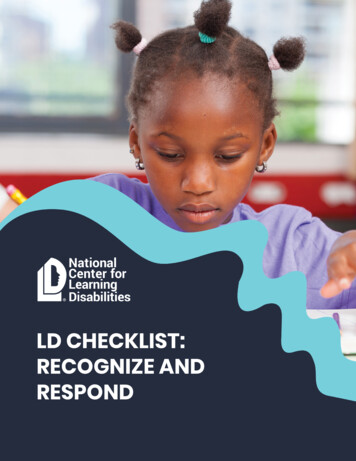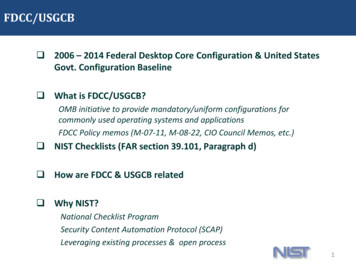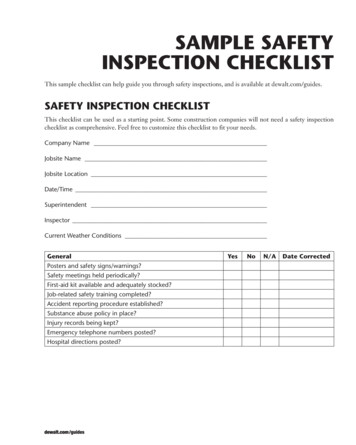
Transcription
LD CHECKLIST:RECOGNIZE ANDRESPOND
Most people have challenges with learning and behavior from time to time.During a child’s preschool years and throughout the school years, parentsand educators should be on the alert for consistent and/or persistentpatterns of difficulty that may signal an underlying learning disability(LD). While variations in the course of development are to be expected,unevenness or lags in the mastery of skills and behaviors, even in childrenas young as 4 or 5, should not be ignored. And because LD can co-occurwith other disorders, it’s important to keep careful and complete recordsof observations and impressions. These can be shared among parents,educators, and related service providers to help them make importantdecisions about services and supports.LD—sometimes called specific learning disability or specific learningdisorder—is a term that describes a group of disorders that impactlistening, speaking, reading, writing, reasoning, math, and social skills.Remember: LDs don’t go away! An LD isn’t outgrown or “cured” bymedication, therapy, or expert tutoring.Although LDs are lifelong, they’re not a prescription for failure. Effectiveinstruction and accommodations can minimize learning challenges,maximize strengths, and optimize student potential in academicsettings. Early recognition of warning signs, well-targeted screening andassessment, effective intervention, and ongoing monitoring of progressare critical to helping individuals with LDs to succeed in school, in theworkplace, and in life.This checklist is designed as a tool to understand potential signs of LDs,not to diagnose LDs. The more characteristics you check, the more likelythe individual described is at risk for (or shows signs of) LDs.When filling out this checklist, think about the person’s behavior over atleast the past six months. And when you’re done, if you have questions orconcerns, seek assistance from school personnel or other professionalswho can help determine whether a comprehensive evaluation is needed.LD Checklist: Recognize and Respond2
Gross and Fine Motor SkillsAppears awkward and clumsy by dropping or spilling things, orknocking them overPreschoolGrades K-4XXHas limited success with games and activities that demandchanges in body position and/or hand-eye coordinationXHas trouble with buttons, hooks, snaps, zippers, and/or learning to tie shoesXXHas trouble copying and drawing shapes and simple figuresand creates artwork that lacks detail and seems immature forageXXDemonstrates poor ability to color or write “within the lines”XXGrasps pencil awkwardly, resulting in poor handwriting or trouble using utensilsXXExperiences difficulty using small objects or items that demand precision (e.g., Legos, puzzle pieces, tweezers, scissors)XXGrades5-8High School& AdultXXXXLanguageDemonstrates early delays in learning to speakXHas difficulty modulating voice (e.g., too soft, too loud)XXHas trouble naming people or objects in conversationXXHas difficulty staying on topicXXXInserts invented words into conversationXXXHas difficulty retelling what has just been said and engaging inlong conversationsXXXUses vague, imprecise language and has a limited vocabularyXXXLD Checklist: Recognize and RespondXXX3
Language (Continued)PreschoolDemonstrates slow and halting speech, using lots of fillers(e.g., uh, um, and, you know, so)XUses poor grammar or misuses words in conversation (note:take into account regional and cultural factors)Mispronounces words frequentlyXConfuses words with others that sound similarGrades K-4Grades5-8High School& AdultXXXXXXXXXXXXXXInserts malapropisms (“slips of the tongue”) into conversation(e.g., a rolling stone gathers no moths; he was a man of greatstatue)XXHas difficulty rhymingXXHas limited interest in books or storiesXXXXHas difficulty understanding instructions or directionsXXXXHas trouble understanding idioms, proverbs, colloquialisms,humor, and/or puns (note: take into account regional andcultural factors)XXXHas difficulty with pragmatic skills (e.g., understanding therelationship between speaker and listener, staying on topic,gauging the listener’s degree of knowledge, making inferencesbased on a speaker’s verbal and nonverbal cues)XXXLD Checklist: Recognize and Respond4
ReadingPreschoolGrades K-4Grades5-8Has difficulty recognizing the small units of sounds (phonemes) in spoken wordsXXXHas difficulty tapping or clapping out the syllables in wordsXXHas problems connecting letters to the sounds they makeXXHas trouble blending sounds together to make wordsXXHas difficulty recognizing and remembering common “sightwords”Has trouble naming letters (e.g., confuses similar lookingletters and numbers)XXHigh School& AdultXXXConfuses similar-looking words (e.g., beard/bread) whilereadingXXReverses letter order in words (e.g., saw/was) while readingand writingXXXXXHas weak comprehension of ideas/themesXXXGuesses at unfamiliar words rather than using word analysisskillsXXXReads slowly, with great effort and poor intonationXXXSubstitutes and/or leaves out words while readingXXXXXXXNeeds to sound out words already encountered in printed textHas poor retention of new vocabularyDislikes and/or avoids learning letters or readingLD Checklist: Recognize and RespondXXX5
Written LanguagePreschoolGrades K-4Grades5-8High School& AdultDislikes and avoids writing and copyingXXXXDemonstrates delays in learning to copy and writeXXXXHas messy and incomplete writing, with many cross-outs anderasuresXHas difficulty remembering shapes of letters and numeralsXXFrequently reverses or misdraws letters, numbers, and symbolsXXUses uneven spacing between letters and words, and has trouble staying “on the line”XXXCopies inaccurately (e.g., confuses similar-looking letters andnumbers)XXXSpells poorly and inconsistently (e.g., the same word appearsdifferently other places in the same documentXXXHas difficulty proofreading and self-correcting written or printed workXXXXXXXXXXDoes not appear to listen when spoken to directlyXXXDoes not follow through on instructions and fails to finishschoolwork, chores, or duties in the workplaceXXXFails to develop ideas in writing (e.g., written work is incomplete, too brief or disorganizedAttentionFails to pay close attention to details or makes careless mistakes in schoolwork, work, or other activitiesHas difficulty sustaining attention in play activities and worktasksLD Checklist: Recognize and RespondX6
Attention (Continued)Grades K-4Grades5-8High School& AdultXXXXXXConsistently loses things that are necessary for tasks/activities (e.g., toys, school assignments, pencils, books, or tools)XXXIs easily distracted by sounds, motion, or other stimuliXXXIs forgetful in daily/routine activitiesXXXPreschoolHas difficulty organizing tasks and activitiesAvoids, dislikes, and/or is reluctant to engage in tasks thatrequire sustained mental effort (e.g., homework, organizingwork tasks)XMathHas difficulty with simple counting and one-to-one correspondence between number symbols and objectsXXHas difficulty recognizing quantities without countingXXXXHas difficulty learning to calculate and memorize basic addition, subtraction, and multiplication factsXXXHas difficulty learning and performing strategic counting activities (e.g., by 2, 5, 10, 100)XXXHas trouble positioning numbers in the correct places (e.g.,one on top of the other), resulting in computation errorsXXXHas difficulty estimating (e.g., quantity, value)XXXXHas difficulty with comparisons (e.g., less than, greater than)XXXXHas trouble telling time (on either a digital or analog clock)XXXHas trouble learning and applying formulas and rules for calculation and problem solvingXXHas trouble reading and interpreting graphs and chartsXXLD Checklist: Recognize and Respond7
Social/EmotionalGrades K-4Grades5-8High School& AdultDoes not pick up on other people’s moods/feelings (e.g., maysay the wrong thing at the wrong time)XXXMay not detect or respond appropriately to teasingXXXXXXXXXXHas trouble setting realistic social goalsXXHas trouble evaluating personal social strengths andchallengesXXHas doubts about abilities and is prone to attribute successesto luck or outside influences rather than hard workXXPreschoolHas difficulty “joining in” and maintaining positive social statusin a peer groupXHas trouble knowing how to share/express feelingsHas difficulty with self-control when frustratedXHas difficulty dealing with group pressure, embarrassment, andunexpected challengesXXOtherConfuses left and rightXXXHas a poor sense of direction; is slow to learn the way around anew place; is easily lost or confused in unfamiliar surroundingsXXXXXXHas trouble reading mapsXXIs disorganized and poor at planningXXFinds it hard to judge speed and distance (e.g., playing sports,driving a car)LD Checklist: Recognize and RespondX8
Other (Continued)PreschoolGrades K-4Grades5-8High School& AdultXXXXXXXXXXXOften loses thingsIs slow to learn new games and master puzzlesHas difficulty listening and taking notes at the same timeXPerforms inconsistently on tasks from one day to the nextHas difficulty generalizing (applying) skills from one situationto anotherXMORE RESOURCESThis printable checklist is just one of a series of resources that NCLD created as part of TheLD Checklist: Recognize and Respond tool. This includes: The LD Checklist: Recognize and Respond: This interactive tool builds upon the mostrecent research so parents and other caregivers can determine whether a child is at riskfor, or shows signs of, having learning disabilities. The more characteristics checked,the more important it is to seek clarification about the presence of underlying learningdisabilities.The Importance of Early Screening: This resource provides information on what ascreening is and why screening for learning difficulties is important.Parent Guide: Questions to Ask Pediatricians If Your Child Is StrugglingParent Guide: Questions to Ask Educators If Your Child Is StrugglingResources From Our Partners: In collaboration with researchers, neuroscientists, andother experts, we’ve created a collection of high-quality resources that is easy to use andhelpful to a range of care providers.To access all of the resources, visit www.ncld.org/LDChecklist.National Center for Learning DisabilitiesFor more information, visit www.ncld.org or contact NCLD via email: info@ncld.orgP.O. Box 34056, Washington, DC 20043 2020 National Center for Learning DisabilitiesLD Checklist: Recognize and Respond9
assessment, effective intervention, and ongoing monitoring of progress are critical to helping individuals with LDs to succeed in school, in the workplace, and in life. This checklist is designed as a tool to understand potential signs of LDs, not to diagnose LDs. The more characteristics you check, the more likely











